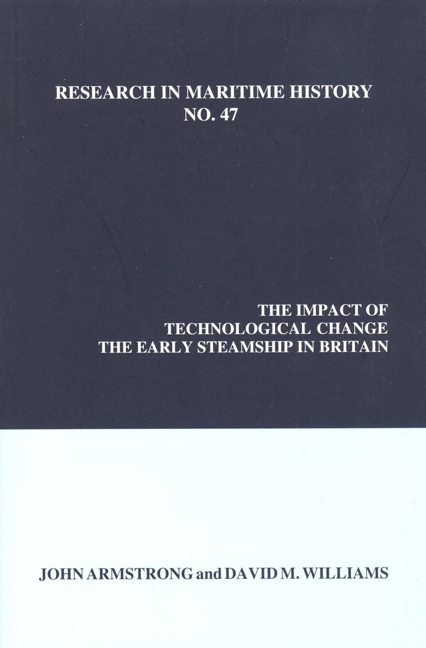Book contents
- Frontmatter
- Contents
- Series Editor's Foreword
- About the Authors
- Introduction
- Chapter 1 British Steam Navigation, 1812 to the 1850s: A Bibliographical and Historiographical Review
- Chapter 2 Some Official Listings of “Vessels Navigated by Steam” in Britain up to 1851: Evidence and Interpretation
- Chapter 3 The Steamboat, Safety and the State: Government Reaction to New Technology in a Period of Laissez-Faire
- Chapter 4 The Steamboat and Popular Tourism
- Chapter 5 The Thames and Recreation, 1815-1840
- Chapter 6 Steam Shipping and the Beginnings of Overseas Tourism: British Travel to North Western Europe, 1820-1850
- Chapter 7 Technological Advance and Innovation: The Diffusion of the Early Steamship in the United Kingdom, 1812-1834
- Chapter 8 The Steamship as an Agent of Modernisation, 1812-1840
- Chapter 9 “A New and Very Modern Business:” The Traffic and Operations of the Early Steamship
- Chapter 10 Promotion, Speculation and Their Outcome: The “Steamship Mania” of 1824-1825
- Chapter 11 The Perception and Understanding of New Technology: A Failed Attempt to Establish Transatlantic Steamship Liner Services, 1824-1828
- Chapter 12 The “Norwich Explosion” of 1817: A Local Tragedy of National Significance
- Chapter 13 Early Steamboat Services and Their Impact in North Wales, 1817-1840s
- Chapter 14 The Beginnings of a New Technology: The Constructors of Early Steamboats, 1812-1822
Chapter 4 - The Steamboat and Popular Tourism
- Frontmatter
- Contents
- Series Editor's Foreword
- About the Authors
- Introduction
- Chapter 1 British Steam Navigation, 1812 to the 1850s: A Bibliographical and Historiographical Review
- Chapter 2 Some Official Listings of “Vessels Navigated by Steam” in Britain up to 1851: Evidence and Interpretation
- Chapter 3 The Steamboat, Safety and the State: Government Reaction to New Technology in a Period of Laissez-Faire
- Chapter 4 The Steamboat and Popular Tourism
- Chapter 5 The Thames and Recreation, 1815-1840
- Chapter 6 Steam Shipping and the Beginnings of Overseas Tourism: British Travel to North Western Europe, 1820-1850
- Chapter 7 Technological Advance and Innovation: The Diffusion of the Early Steamship in the United Kingdom, 1812-1834
- Chapter 8 The Steamship as an Agent of Modernisation, 1812-1840
- Chapter 9 “A New and Very Modern Business:” The Traffic and Operations of the Early Steamship
- Chapter 10 Promotion, Speculation and Their Outcome: The “Steamship Mania” of 1824-1825
- Chapter 11 The Perception and Understanding of New Technology: A Failed Attempt to Establish Transatlantic Steamship Liner Services, 1824-1828
- Chapter 12 The “Norwich Explosion” of 1817: A Local Tragedy of National Significance
- Chapter 13 Early Steamboat Services and Their Impact in North Wales, 1817-1840s
- Chapter 14 The Beginnings of a New Technology: The Constructors of Early Steamboats, 1812-1822
Summary
A vital factor in the development of popular travel, popular both in the sense of an attractive and accessible product, was that of improvements in transport. Progress in transport, in terms of passengers, embodies the ability to convey passengers more cheaply, more rapidly and in greater numbers. In the history of both popular recreation and tourism, the widely held view is that the railway was the first transport mode able to provide efficient mass travel facilities. Hence, the railway played a major role in promoting the developments of tourism and resorts and was the instigator of the day excursion. In the latter instance, the story of Thomas Cook's first excursion in 1841, which conveyed over four hundred persons by rail from Leicester to Loughborough for a temperance rally, has become a legend. The outing is held up as the first example of such recreational travel activity involving large numbers, and Cook was hailed as an innovative pioneer who “made the largest single contribution of any man to the growth of a new industry.” In fact, Cook's Loughborough venture was not the first public rail excursion - others had occurred from the mid-1830s. Nevertheless, the beginning of excursion travel is widely associated with the coming of the railway. Pimlott, one of the earliest historians of recreation, observed that the railway excursion “effectively began the era of cheap holiday travel for the masses.” Likewise, lengthier recreational stays away from home involving travel - weekend or longer holidays - for a wider public than the very rich are viewed as a function of the speedier transit brought by rail. In consequence, the early development of some seaside resorts is attributed to their connection with the rail network.
This study argues that the case of the railway in promoting popular recreational travel, introducing excursions and encouraging resort development has been over-emphasized and in some instances has been wrongly credited with a pioneering role. That role, in fact, was played by the steamboat. In fairness to previous writers, some have qualified their studies of the recreational impact of the railway by noting the existence of earlier steamboat pleasure traffic. None, however, has proceeded further and fully considered the extent and significance of that traffic. This paper rectifies this neglect.
- Type
- Chapter
- Information
- The Impact of Technological ChangeThe Early Steamship In Britain, pp. 75 - 96Publisher: Liverpool University PressPrint publication year: 2011



